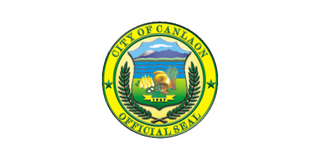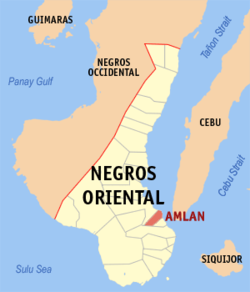
Canlaon, officially the City of Canlaon, is a 4th class component city in the province of Negros Oriental, Philippines. According to the 2020 census, it has a population of 58,822 people.

Basay, officially the Municipality of Basay, is a 4th class municipality in the province of Negros Oriental, Philippines. According to the 2020 census, it has a population of 28,531 people.

Bindoy, officially the Municipality of Bindoy, is a 3rd class municipality in the province of Negros Oriental, Philippines. According to the 2020 census, it has a population of 40,308 people.

Dauin, officially the Municipality of Dauin is a 4th class municipality in the province of Negros Oriental, Philippines. According to the 2020 census, it has a population of 30,018 people.

Manjuyod, officially the Municipality of Manjuyod, is a 2nd class municipality in the province of Negros Oriental, Philippines. According to the 2020 census, it has a population of 44,799 people.

Pamplona, officially the Municipality of Pamplona, is a 3rd class municipality in the province of Negros Oriental, Philippines. According to the 2020 census, it has a population of 39,805 people.

San Jose, officially the Municipality of San Jose, is a 5th class municipality in the province of Negros Oriental, Philippines. According to the 2020 census, it has a population of 21,956 people. It is the least populous town in Negros Oriental.

Zamboanguita, officially the Municipality of Zamboanguita, is a 4th class municipality in the province of Negros Oriental, Philippines. According to the 2020 census, it has a population of 29,569 people.

Silago, officially the Municipality of Silago, is a 4th class municipality in the province of Southern Leyte, Philippines. According to the 2020 census, it has a population of 13,116 people. It was used to be barrio of Hinunangan until Executive Order No. 326 dated May 17, 1951 separated it from the mother town. The town has an ebony beach with unique black sand.

Dumanjug, officially the Municipality of Dumanjug, is a 3rd class municipality in the province of Cebu, Philippines. According to the 2020 census, it has a population of 57,823 people.

Malabuyoc, officially the Municipality of Malabuyoc, is a 5th class municipality in the province of Cebu, Philippines. According to the 2020 census, it has a population of 19,770 people. Malabuyoc is situated in the southwestern coast of the island of Cebu and is 139 kilometres (86 mi) from Cebu City.

Samboan, officially the Municipality of Samboan, is a 5th class municipality in the province of Cebu, Philippines. According to the 2020 census, it has a population of 20,373 people.

Altavas, officially the Municipality of Altavas, is a 4th class municipality in the province of Aklan, Philippines. According to the 2020 census, it has a population of 25,639 people.

Murcia, officially the Municipality of Murcia, is a 1st class municipality in the province of Negros Occidental, Philippines. According to the 2020 census, it has a population of 88,868 people. It is 17 kilometres (11 mi) east of Bacolod.

Buenavista, officially the Municipality of Buenavista, is a 4th class municipality in the province of Bohol, Philippines. According to the 2020 census, it has a population of 29,711 people.

Culaba, officially the Municipality of Culaba, is a 5th class municipality in the province of Biliran, Philippines. According to the 2020 census, it has a population of 12,972 people.The town's populace predominantly speak Waray language.

Hinabangan, officially the Municipality of Hinabangan, is a 4th class municipality in the province of Samar, Philippines. According to the 2020 census, it has a population of 13,693 people.

Jiabong, officially the Municipality of Jiabong, is a 5th class municipality in the province of Samar, Philippines. According to the 2020 census, it has a population of 19,205 people.

Oras, officially the Municipality of Oras, is a 3rd class municipality in the province of Eastern Samar, Philippines. According to the 2020 census, it has a population of 37,451 people.

Saint Bernard, officially the Municipality of Saint Bernard, is a 4th class municipality in the province of Southern Leyte, Philippines. According to the 2020 census, it has a population of 28,414 people.


























